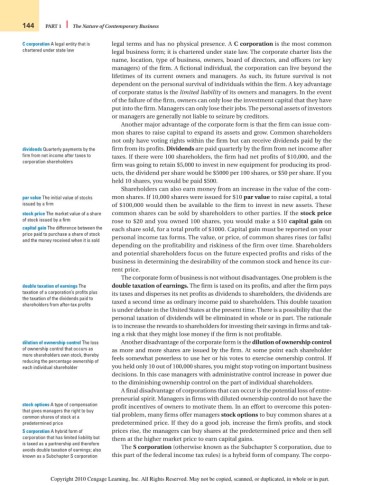Page 170 - Introduction to Business
P. 170
144 PART 1 The Nature of Contemporary Business
C corporation A legal entity that is legal terms and has no physical presence. A C corporation is the most common
chartered under state law legal business form; it is chartered under state law. The corporate charter lists the
name, location, type of business, owners, board of directors, and officers (or key
managers) of the firm. A fictional individual, the corporation can live beyond the
lifetimes of its current owners and managers. As such, its future survival is not
dependent on the personal survival of individuals within the firm. A key advantage
of corporate status is the limited liability of its owners and managers. In the event
of the failure of the firm, owners can only lose the investment capital that they have
put into the firm. Managers can only lose their jobs. The personal assets of investors
or managers are generally not liable to seizure by creditors.
Another major advantage of the corporate form is that the firm can issue com-
mon shares to raise capital to expand its assets and grow. Common shareholders
not only have voting rights within the firm but can receive dividends paid by the
dividends Quarterly payments by the firm from its profits. Dividends are paid quarterly by the firm from net income after
firm from net income after taxes to taxes. If there were 100 shareholders, the firm had net profits of $10,000, and the
corporation shareholders
firm was going to retain $5,000 to invest in new equipment for producing its prod-
ucts, the dividend per share would be $5000 per 100 shares, or $50 per share. If you
held 10 shares, you would be paid $500.
Shareholders can also earn money from an increase in the value of the com-
par value The initial value of stocks mon shares. If 10,000 shares were issued for $10 par value to raise capital, a total
issued by a firm of $100,000 would then be available to the firm to invest in new assets. These
stock price The market value of a share common shares can be sold by shareholders to other parties. If the stock price
of stock issued by a firm rose to $20 and you owned 100 shares, you would make a $10 capital gain on
capital gain The difference between the each share sold, for a total profit of $1000. Capital gain must be reported on your
price paid to purchase a share of stock personal income tax forms. The value, or price, of common shares rises (or falls)
and the money received when it is sold
depending on the profitability and riskiness of the firm over time. Shareholders
and potential shareholders focus on the future expected profits and risks of the
business in determining the desirability of the common stock and hence its cur-
rent price.
The corporate form of business is not without disadvantages. One problem is the
double taxation of earnings The double taxation of earnings. The firm is taxed on its profits, and after the firm pays
taxation of a corporation’s profits plus its taxes and disperses its net profits as dividends to shareholders, the dividends are
the taxation of the dividends paid to
taxed a second time as ordinary income paid to shareholders. This double taxation
shareholders from after-tax profits
is under debate in the United States at the present time. There is a possibility that the
personal taxation of dividends will be eliminated in whole or in part. The rationale
is to increase the rewards to shareholders for investing their savings in firms and tak-
ing a risk that they might lose money if the firm is not profitable.
dilution of ownership control The loss Another disadvantage of the corporate form is the dilution of ownership control
of ownership control that occurs as as more and more shares are issued by the firm. At some point each shareholder
more shareholders own stock, thereby feels somewhat powerless to use her or his votes to exercise ownership control. If
reducing the percentage ownership of
each individual shareholder you held only 10 out of 100,000 shares, you might stop voting on important business
decisions. In this case managers with administrative control increase in power due
to the diminishing ownership control on the part of individual shareholders.
A final disadvantage of corporations that can occur is the potential loss of entre-
preneurial spirit. Managers in firms with diluted ownership control do not have the
stock options A type of compensation profit incentives of owners to motivate them. In an effort to overcome this poten-
that gives managers the right to buy
common shares of stock at a tial problem, many firms offer managers stock options to buy common shares at a
predetermined price predetermined price. If they do a good job, increase the firm’s profits, and stock
S corporation A hybrid form of prices rise, the managers can buy shares at the predetermined price and then sell
corporation that has limited liability but them at the higher market price to earn capital gains.
is taxed as a partnership and therefore The S corporation (otherwise known as the Subchapter S corporation, due to
avoids double taxation of earnings; also
known as a Subchapter S corporation this part of the federal income tax rules) is a hybrid form of company. The corpo-
Copyright 2010 Cengage Learning, Inc. All Rights Reserved. May not be copied, scanned, or duplicated, in whole or in part.

